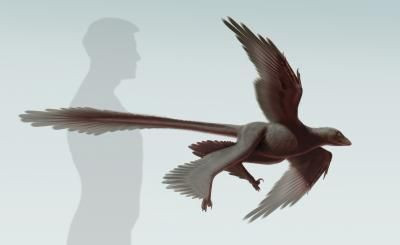Fossil Proves Largest Flying Dinosaur, Changyuraptor, Was A Four-Winged Raptor

Scientists now know more about the fossilized remains of a dinosaur that, while not a bird, appears to have been an expert flier that traversed the skies 125 million years ago.
Luis Chiappe, a paleontologist at the Natural History Museum of Los Angeles County, has co-authored a study based on what USA Today reported was an “exquisitely detailed fossil” unearthed in northeastern China. The dinosaur, officially known as a Changyuraptor yangi, weighed 9 pounds (6 pounds heavier than the Microraptor, a seagull-sized four-winged dinosaur) and measured more than 4 feet long (60 percent longer than the Microraptor).
“I’ve worked for over 20 years in China, and I’ve never seen anything like this,” Chiappe told USA Today. “It was absolutely stunning to see how perfectly preserved these feathers were and how long they were … essentially one-fourth the length of the animal.”
The species also had large teeth and sharp claws, and there are indications it was a carnivore. Chiappe admitted researchers are unsure about the Changyuraptor’s exact diet, adding similar beasts have been found with fish and birds in their systems at the time of death.
Changyuraptor was found in 2012 in the Liaoning province in northeastern China, which has seen a number of discoveries of feathered dinosaurs in recent years. Its name comes from the combination of “long-feathered raptor” and the name of one of the Chinese financial backers who funded the research.
The Liaoning province was a large peninsula that stretched into the ocean when the Changyuraptor roamed, Chiappe said, with lakes in the region serving as home to frogs and salamanders.
“It was a moist temperate forest, mostly of conifer trees and gingkos, with dry hot summers and pretty cold winters,” he told Live Science. “There were a variety of meat-eating and plant-eating dinosaurs in the area, including Yutrrannus, a feathered relative of Tyrannosaurus maybe 27 to 30 feet long.”
Experts are still unsure if the changyuraptor was able to fly on its own power -- initially lifting itself into the air may have been an insurmountable challenge -- yet the discovery lends more credibility to the idea that prehistoric birds were not the only creatures that could fly.
Paleontologist David Gone of the University of Bristol told USA Today it’s simply so surprising to find an airborne dinosaur that might have been able to fly that scientists are alarmed. They expected the Microraptor “to be around the biggest and everything else to be comparable or smaller. … Then you’ve got this new guy, and it’s really quite a lot bigger.”
© Copyright IBTimes 2025. All rights reserved.





















